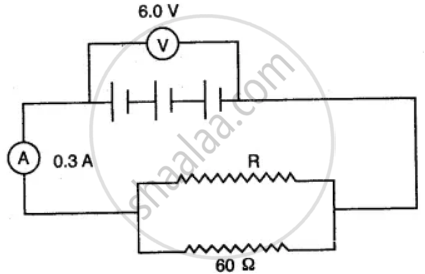Advertisements
Advertisements
प्रश्न
A piece of wire having a resistance R is cut into five equal parts.
- How will the resistance of each part of the wire change compared with the original resistance?
- If the five parts of the wire are placed in parallel, how will the resistance of the combination change?
- What will be ratio of the effective resistance in series connection to that of the parallel connection?
उत्तर
- Consider a piece of wire having resistance R. It cut into 5 equal parts. So number of equal resistros are 5. n = 5
When ‘n’ resistors of equal resistance R are connected in series, the equivalent resistance is ‘nR’
RS = nR
⇒ RS = 5R
⇒ R = \(\frac{\mathrm{R}_{\mathrm{s}}}{5}\)
⇒ R = 0.2 RS
Each part of resistance ‘R’ is equal to 0.2 times of original resistance. - Effective Resistance of 5 Resistors
`1/"R"_"P" = 1/"R" + 1/"R" + 1/"R" + 1/"R" + 1/"R" = 5/"R"`
`"R"_"P" = "R"/5` = 0.2 R - Effective resistance of series combination RS = 5R
Effective resistance of parallel combination
`"R"_"P" = "R"/5`
The ratio of series connection to the parallel connection
`"R"_"S"/"R"_"P" = (5"R")/("R"//"S")`
(2) (9 - R2 - + R2) = (9 - R2)R2
`"R"_"S"/"R"_"P" = 5 "R" xx 5/"R" = 25`
RS : RP = 25 : 1
APPEARS IN
संबंधित प्रश्न
What are the advantages of connecting electrical devices in parallel with the battery instead of connecting them in series?
A hot plate of an electric oven connected to a 220 V line has two resistance coils A and B, each of 24 Ω resistances, which may be used separately, in series, or in parallel. What are the currents in the three cases?
State how are the two resistors joined with a battery when equivalent resistance is less than either of the two resistances.
A particular resistance wire has a resistance of 3 ohm per meter. Find the total resistance of three lengths of this wire each 1.5 m long, joined in parallel.
A uniform wire with a resistance of 27 Ω is divided into three equal pieces and then they are joined in parallel. Find the equivalent resistance of the parallel combination.
A given wire is stretched to double its length. How will its resistance change?
In the figure below, the ammeter A reads 0.3 A. Calculate:
(i) the total resistance of the circuit
(ii) the value of R
(iii) the current flowing through R.

A coil in the heater consumes power P on passing current. If it is cut into halves and joined in parallel, it will consume power:
You are given four ammeters A, B, C and D having the least counts mentioned below:
(I) Ammeter A with least count 0.25 A
(II) Ammeter B with least count 0.5 A
(III) Ammeter C with least count 0.05 A
(IV) Ammeter D with least count 0.1 A
Which of the ammeters would you prefer for doing an experiment to determine the equivalent resistance of two resistances most accurately, when connected in parallel?
Two resistors of resistance 2 Ω and 3 Ω are connected in parallel to a cell to draw current 0.5 A from the cell. Calculate the current in each resistor.
